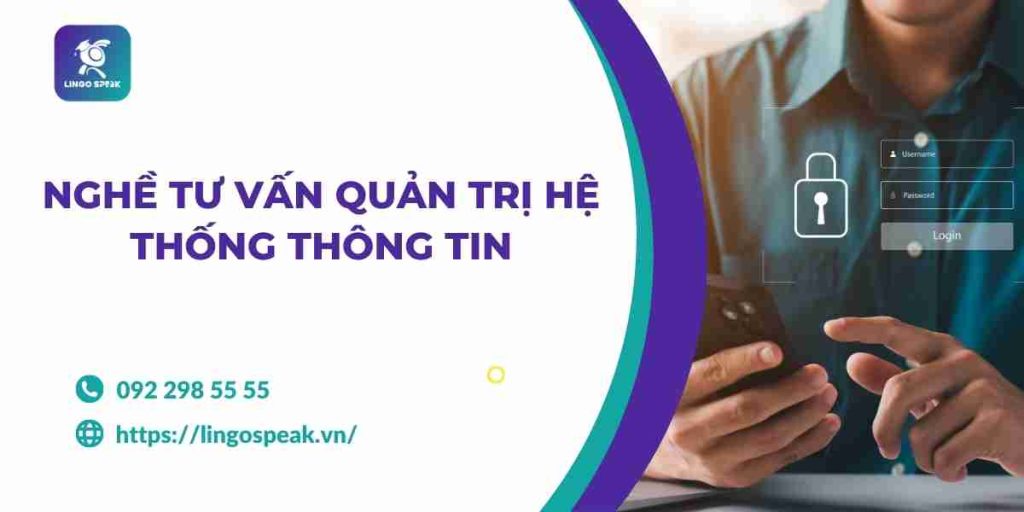Ngành tư vấn quản trị hệ thống thông tin đòi hỏi sự am hiểu về công nghệ và kỹ năng quản lý. Bộ từ vựng 100 từ và cụm từ vựng tiếng Anh dưới đây sẽ giúp bạn làm quen với các thuật ngữ chuyên ngành, từ đó nâng cao khả năng giao tiếp và quản lý trong môi trường quốc tế.
Từ vựng nghề Tư vấn quản trị hệ thống thông tin
- Information Systems Management – Quản trị hệ thống thông tin
- IT Consultant – Tư vấn công nghệ thông tin
- System Integration – Tích hợp hệ thống
- Business Analysis – Phân tích kinh doanh
- Project Management – Quản lý dự án
- Software Implementation – Triển khai phần mềm
- Database Management – Quản lý cơ sở dữ liệu
- Network Architecture – Kiến trúc mạng
- IT Strategy – Chiến lược công nghệ thông tin
- Change Management – Quản lý thay đổi
- Enterprise Resource Planning (ERP) – Lập kế hoạch nguồn lực doanh nghiệp
- Customer Relationship Management (CRM) – Quản lý quan hệ khách hàng
- IT Governance – Quản trị công nghệ thông tin
- Risk Assessment – Đánh giá rủi ro
- Data Security – Bảo mật dữ liệu
- System Auditing – Kiểm toán hệ thống
- IT Infrastructure – Hạ tầng công nghệ thông tin
- Business Process Optimization – Tối ưu hóa quy trình kinh doanh
- Cloud Computing – Điện toán đám mây
- Business Continuity Planning – Lập kế hoạch liên tục kinh doanh
- Data Analytics – Phân tích dữ liệu
- Information Security Management – Quản lý an ninh thông tin
- User Training – Đào tạo người dùng
- System Design – Thiết kế hệ thống
- IT Support – Hỗ trợ công nghệ thông tin
- Compliance – Tuân thủ quy định
- Performance Monitoring – Giám sát hiệu suất
- IT Policies – Chính sách công nghệ thông tin
- Technical Documentation – Tài liệu kỹ thuật
- System Development Life Cycle (SDLC) – Chu trình phát triển hệ thống
- Software Development – Phát triển phần mềm
- Data Migration – Di chuyển dữ liệu
- Application Support – Hỗ trợ ứng dụng
- Vendor Management – Quản lý nhà cung cấp
- IT Service Management (ITSM) – Quản lý dịch vụ công nghệ thông tin
- Business Intelligence (BI) – Thông tin kinh doanh
- Solution Architecture – Kiến trúc giải pháp
- Technology Roadmap – Lộ trình công nghệ
- System Configuration – Cấu hình hệ thống
- Integration Testing – Kiểm thử tích hợp
- IT Compliance – Tuân thủ công nghệ thông tin
- Backup and Recovery – Sao lưu và phục hồi
- Technical Support – Hỗ trợ kỹ thuật
- Data Management – Quản lý dữ liệu
- Service Level Agreement (SLA) – Thỏa thuận mức độ dịch vụ
- Process Improvement – Cải tiến quy trình
- IT Architecture – Kiến trúc công nghệ thông tin
- Resource Allocation – Phân bổ tài nguyên
- User Experience (UX) – Trải nghiệm người dùng
- System Upgrades – Nâng cấp hệ thống
- Application Integration – Tích hợp ứng dụng
- Technology Assessment – Đánh giá công nghệ
- Incident Management – Quản lý sự cố
- Knowledge Management – Quản lý tri thức
- ITIL (Information Technology Infrastructure Library) – Thư viện cơ sở hạ tầng công nghệ thông tin
- Service Desk – Quầy dịch vụ
- IT Operations – Vận hành công nghệ thông tin
- Data Warehousing – Kho dữ liệu
- Solution Design – Thiết kế giải pháp
- Resource Management – Quản lý tài nguyên
- Change Control – Kiểm soát thay đổi
- Risk Management – Quản lý rủi ro
- System Testing – Kiểm thử hệ thống
- Quality Assurance (QA) – Đảm bảo chất lượng
- Technology Consulting – Tư vấn công nghệ
- Business Requirements Gathering – Thu thập yêu cầu kinh doanh
- Data Visualization – Trực quan hóa dữ liệu
- Infrastructure Management – Quản lý cơ sở hạ tầng
- Cost Management – Quản lý chi phí
- Service Management – Quản lý dịch vụ
- IT Budgeting – Lập ngân sách công nghệ thông tin
- Information Management – Quản lý thông tin
- End-user Support – Hỗ trợ người dùng cuối
- Performance Metrics – Chỉ số hiệu suất
- Technical Analysis – Phân tích kỹ thuật
- Project Scope – Phạm vi dự án
- Stakeholder Engagement – Tham gia của các bên liên quan
- Application Development – Phát triển ứng dụng
- System Integration Testing – Kiểm thử tích hợp hệ thống
- IT Risk Management – Quản lý rủi ro công nghệ thông tin
- Technology Integration – Tích hợp công nghệ
- User Requirements – Yêu cầu người dùng
- IT Infrastructure Planning – Lập kế hoạch cơ sở hạ tầng công nghệ thông tin
- Disaster Recovery – Khôi phục sau thảm họa
- Service Delivery – Cung cấp dịch vụ
- Change Management Process – Quy trình quản lý thay đổi
- Compliance Audit – Kiểm toán tuân thủ
- IT Solutions – Giải pháp công nghệ thông tin
- Data Governance – Quản trị dữ liệu
- System Maintenance – Bảo trì hệ thống
- Capacity Planning – Lập kế hoạch năng lực
- Knowledge Base – Cơ sở tri thức
- System Architecture – Kiến trúc hệ thống
- Operational Efficiency – Hiệu quả vận hành
- IT Security – An ninh công nghệ thông tin
- Application Deployment – Triển khai ứng dụng
- Service Improvement – Cải tiến dịch vụ
- Technology Upgrades – Nâng cấp công nghệ
- IT Strategy Planning – Lập kế hoạch chiến lược công nghệ thông tin
- Consulting Services – Dịch vụ tư vấn
Bài viết sử dụng thuật ngữ trên
- Information Systems Management is crucial for maintaining operational efficiency in businesses.
- An IT Consultant helps organizations optimize their technology strategies.
- System Integration ensures that different software systems work together seamlessly.
- Business Analysis helps identify the needs and solutions for improving business processes.
- Project Management involves planning, executing, and overseeing projects to ensure they are completed on time.
- Software Implementation requires careful planning to ensure the software meets business requirements.
- Database Management is essential for organizing and maintaining a company’s data.
- Network Architecture defines the layout and structure of a company’s network infrastructure.
- IT Strategy outlines the technology goals and objectives for an organization.
- Change Management helps organizations adapt to technological changes smoothly.
- Enterprise Resource Planning (ERP) systems integrate core business processes into a single platform.
- Customer Relationship Management (CRM) software helps manage interactions with current and potential customers.
- IT Governance involves the processes and structures that ensure IT investments support business goals.
- Risk Assessment is used to identify and evaluate potential risks to an organization’s IT systems.
- Data Security measures are essential to protect sensitive information from unauthorized access.
- System Auditing involves reviewing and assessing the performance of IT systems.
- IT Infrastructure includes the hardware, software, and networks that support an organization’s IT services.
- Business Process Optimization aims to improve the efficiency and effectiveness of business operations.
- Cloud Computing offers scalable and flexible computing resources over the internet.
- Business Continuity Planning ensures that critical business functions can continue during a disruption.
- Data Analytics involves analyzing data to make informed business decisions.
- Information Security Management focuses on protecting information assets from security threats.
- User Training is important for ensuring employees can effectively use new systems and software.
- System Design involves creating a blueprint for how a system will operate and meet user needs.
- IT Support provides assistance with technical issues and troubleshooting.
- Compliance ensures that IT systems and processes adhere to legal and regulatory requirements.
- Performance Monitoring tracks the efficiency and effectiveness of IT systems.
- IT Policies define the rules and guidelines for managing IT resources and operations.
- Technical Documentation provides detailed information on the system’s design, implementation, and maintenance.
- The System Development Life Cycle (SDLC) outlines the phases of developing an information system.
- Software Development involves creating, designing, and maintaining software applications.
- Data Migration is the process of transferring data from one system to another.
- Application Support provides help with software applications to ensure they function correctly.
- Vendor Management involves managing relationships with external suppliers of IT products and services.
- IT Service Management (ITSM) focuses on delivering and managing IT services to meet business needs.
- Business Intelligence (BI) tools help analyze and visualize business data for decision-making.
- Solution Architecture involves designing comprehensive IT solutions to address business needs.
- A Technology Roadmap outlines the planned evolution of technology within an organization.
- System Configuration involves setting up and adjusting system settings to meet requirements.
- Integration Testing ensures that different system components work together as intended.
- IT Compliance ensures that IT systems and processes adhere to industry standards and regulations.
- Backup and Recovery procedures are critical for protecting data and restoring it after a loss.
- Technical Support assists users with resolving hardware and software issues.
- Data Management involves organizing, storing, and maintaining data for efficient access and use.
- A Service Level Agreement (SLA) defines the expected performance and service standards between service providers and clients.
- Process Improvement focuses on enhancing business processes to increase efficiency and effectiveness.
- IT Architecture encompasses the design and structure of IT systems and infrastructure.
- Resource Allocation involves distributing resources effectively to support business operations.
- User Experience (UX) design aims to create intuitive and user-friendly interfaces.
- System Upgrades involve updating system components to improve performance and functionality.
- Application Integration ensures that different software applications work together seamlessly.
- Technology Assessment evaluates current technology and identifies areas for improvement.
- Incident Management involves responding to and managing IT incidents to minimize impact.
- Knowledge Management is the process of capturing, sharing, and utilizing organizational knowledge.
- ITIL (Information Technology Infrastructure Library) provides a set of practices for IT service management.
- The Service Desk handles user requests and provides support for IT-related issues.
- IT Operations encompass the day-to-day management of IT systems and services.
- Data Warehousing involves collecting and storing data from various sources for analysis and reporting.
- Solution Design involves creating detailed plans for implementing IT solutions.
- Resource Management focuses on efficiently utilizing IT resources to meet business goals.
- Change Control involves managing changes to IT systems to minimize disruptions.
- Risk Management identifies and mitigates potential risks to IT systems and operations.
- System Testing ensures that IT systems function as expected and meet requirements.
- Quality Assurance (QA) ensures that IT products and services meet quality standards.
- Technology Consulting provides expert advice on technology solutions and strategies.
- Business Requirements Gathering involves collecting and analyzing requirements for IT projects.
- Data Visualization tools help present data in graphical formats for easier interpretation.
- Infrastructure Management involves overseeing and maintaining IT infrastructure components.
- Cost Management focuses on budgeting and controlling costs associated with IT projects and operations.
- Service Management encompasses the planning and delivery of IT services to meet business needs.
- IT Budgeting involves planning and allocating financial resources for IT investments and operations.
- Information Management involves overseeing the use and organization of information within an organization.
- End-user Support provides assistance to users in resolving technical issues and using IT systems.
- Performance Metrics are used to measure and evaluate the effectiveness of IT systems and services.
- Technical Analysis involves examining and assessing technical aspects of IT systems.
- Project Scope defines the boundaries and deliverables of an IT project.
- Stakeholder Engagement involves involving key stakeholders in the planning and execution of IT projects.
- Application Development focuses on creating and maintaining software applications.
- System Integration Testing ensures that all system components work together as expected.
- IT Risk Management involves identifying and addressing risks related to IT systems and operations.
- Technology Integration involves combining different technologies to create a unified system.
- User Requirements define the needs and expectations of users for IT systems and solutions.
- IT Infrastructure Planning involves designing and planning the IT infrastructure to support business operations.
- Disaster Recovery involves preparing and implementing plans to recover IT systems after a disaster.
- Service Delivery encompasses the provision and management of IT services to users.
- The Change Management Process outlines the steps for implementing changes to IT systems.
- Compliance Audit reviews and assesses adherence to regulations and standards.
- IT Solutions are tailored technology solutions designed to address specific business challenges.
- Data Governance ensures the proper management and protection of data within an organization.
- System Maintenance involves regular updates and repairs to keep IT systems functioning properly.
- Capacity Planning involves forecasting and managing the IT resources needed to support business growth.
- A Knowledge Base provides a repository of information and solutions for IT support and troubleshooting.
- System Architecture defines the overall structure and design of IT systems.
- Operational Efficiency measures how effectively IT operations support business objectives.
- IT Security focuses on protecting IT systems and data from security threats and breaches.
- Application Deployment involves installing and configuring software applications for use.
- Service Improvement aims to enhance the quality and effectiveness of IT services.
- Technology Upgrades involve replacing or enhancing existing technology to improve performance.
- IT Strategy Planning involves developing a strategic plan to align IT initiatives with business goals.
- Consulting Services provide expert advice and support for managing and optimizing IT systems.
Bài tập
- Effective ___________ is essential for aligning IT with business goals.
- An ___________ helps businesses optimize their technology strategies and systems.
- ___________ ensures that different software systems work together seamlessly.
- ___________ helps identify the needs and solutions for improving business processes.
- ___________ involves planning, executing, and overseeing projects to ensure they are completed on time.
- ___________ requires careful planning to ensure the software meets business requirements.
- ___________ is crucial for organizing and maintaining a company’s data.
- ___________ defines the layout and structure of a company’s network infrastructure.
- An ___________ outlines the technology goals and objectives for an organization.
- ___________ helps organizations adapt to technological changes smoothly.
- ___________ systems integrate core business processes into a single platform.
- ___________ software helps manage interactions with current and potential customers.
- ___________ involves the processes and structures that ensure IT investments support business goals.
- ___________ is used to identify and evaluate potential risks to an organization’s IT systems.
- ___________ measures are essential to protect sensitive information from unauthorized access.
- ___________ involves reviewing and assessing the performance of IT systems.
- ___________ includes the hardware, software, and networks that support an organization’s IT services.
- ___________ aims to improve the efficiency and effectiveness of business operations.
- ___________ offers scalable and flexible computing resources over the internet.
- ___________ ensures that critical business functions can continue during a disruption.
- ___________ involves analyzing data to make informed business decisions.
- ___________ focuses on protecting information assets from security threats.
- ___________ is important for ensuring employees can effectively use new systems and software.
- ___________ involves creating a blueprint for how a system will operate and meet user needs.
- ___________ provides assistance with technical issues and troubleshooting.
- ___________ ensures that IT systems and processes adhere to legal and regulatory requirements.
- ___________ tracks the efficiency and effectiveness of IT systems.
- ___________ define the rules and guidelines for managing IT resources and operations.
- ___________ provides detailed information on the system’s design, implementation, and maintenance.
- The ___________ outlines the phases of developing an information system.
- ___________ involves creating, designing, and maintaining software applications.
- ___________ is the process of transferring data from one system to another.
- ___________ provides help with software applications to ensure they function correctly.
- ___________ involves managing relationships with external suppliers of IT products and services.
- ___________ focuses on delivering and managing IT services to meet business needs.
- ___________ tools help analyze and visualize business data for decision-making.
- ___________ involves designing comprehensive IT solutions to address business needs.
- A ___________ outlines the planned evolution of technology within an organization.
- ___________ involves setting up and adjusting system settings to meet requirements.
- ___________ ensures that different system components work together as intended.
- ___________ ensures that IT systems and processes adhere to industry standards and regulations.
- ___________ procedures are critical for protecting data and restoring it after a loss.
- ___________ assists users with resolving hardware and software issues.
- ___________ involves organizing, storing, and maintaining data for efficient access and use.
- A ___________ defines the expected performance and service standards between service providers and clients.
- ___________ focuses on enhancing business processes to increase efficiency and effectiveness.
- ___________ encompasses the design and structure of IT systems and infrastructure.
- ___________ involves distributing resources effectively to support business operations.
- ___________ design aims to create intuitive and user-friendly interfaces.
- ___________ involve updating system components to improve performance and functionality.
- ___________ ensures that different software applications work together seamlessly.
- ___________ evaluates current technology and identifies areas for improvement.
- ___________ involves responding to and managing IT incidents to minimize impact.
- ___________ is the process of capturing, sharing, and utilizing organizational knowledge.
- ___________ provides a set of practices for IT service management.
- The ___________ handles user requests and provides support for IT-related issues.
- ___________ encompass the day-to-day management of IT systems and services.
- ___________ involves collecting and storing data from various sources for analysis and reporting.
- ___________ involves creating detailed plans for implementing IT solutions.
- ___________ focuses on efficiently utilizing IT resources to meet business goals.
- ___________ involves managing changes to IT systems to minimize disruptions.
- ___________ identifies and mitigates potential risks to IT systems and operations.
- ___________ ensures that IT systems function as expected and meet requirements.
- ___________ ensures that IT products and services meet quality standards.
- ___________ provides expert advice on technology solutions and strategies.
- ___________ involves collecting and analyzing requirements for IT projects.
- ___________ tools help present data in graphical formats for easier interpretation.
- ___________ involves overseeing and maintaining IT infrastructure components.
- ___________ focuses on budgeting and controlling costs associated with IT projects and operations.
- ___________ encompasses the planning and delivery of IT services to meet business needs.
- ___________ involves planning and allocating financial resources for IT investments and operations.
- ___________ involves overseeing the use and organization of information within an organization.
- ___________ provides assistance to users in resolving technical issues and using IT systems.
- ___________ are used to measure and evaluate the effectiveness of IT systems and services.
- ___________ involves examining and assessing technical aspects of IT systems.
- ___________ defines the boundaries and deliverables of an IT project.
- ___________ involves involving key stakeholders in the planning and execution of IT projects.
- ___________ focuses on creating and maintaining software applications.
- ___________ ensures that all system components work together as expected.
- ___________ involves identifying and addressing risks related to IT systems and operations.
- ___________ involves combining different technologies to create a unified system.
- ___________ define the needs and expectations of users for IT systems and solutions.
- ___________ involves designing and planning the IT infrastructure to support business operations.
- ___________ involves preparing and implementing plans to recover IT systems after a disaster.
- ___________ encompasses the provision and management of IT services to users.
- The ___________ outlines the steps for implementing changes to IT systems.
- ___________ reviews and assesses adherence to regulations and standards.
- ___________ are tailored technology solutions designed to address specific business challenges.
- ___________ ensures the proper management and protection of data within an organization.
- ___________ involves regular updates and repairs to keep IT systems functioning properly.
- ___________ involves forecasting and managing the IT resources needed to support business growth.
- A ___________ provides a repository of information and solutions for IT support and troubleshooting.
- ___________ defines the overall structure and design of IT systems.
- ___________ measures how effectively IT operations support business objectives.
- ___________ focuses on protecting IT systems and data from security threats and breaches.
- ___________ involves installing and configuring software applications for use.
- ___________ aims to enhance the quality and effectiveness of IT services.
- ___________ involve replacing or enhancing existing technology to improve performance.
- ___________ involves developing a strategic plan to align IT initiatives with business goals.
- ___________ provide expert advice and support for managing and optimizing IT systems.
Đáp án
- Information Systems Management
- IT Consultant
- System Integration
- Business Analysis
- Project Management
- Software Implementation
- Database Management
- Network Architecture
- IT Strategy
- Change Management
- Enterprise Resource Planning (ERP)
- Customer Relationship Management (CRM)
- IT Governance
- Risk Assessment
- Data Security
- System Auditing
- IT Infrastructure
- Business Process Optimization
- Cloud Computing
- Business Continuity Planning
- Data Analytics
- Information Security Management
- User Training
- System Design
- IT Support
- Compliance
- Performance Monitoring
- IT Policies
- Technical Documentation
- System Development Life Cycle (SDLC)
- Software Development
- Data Migration
- Application Support
- Vendor Management
- IT Service Management (ITSM)
- Business Intelligence (BI)
- Solution Architecture
- Technology Roadmap
- System Configuration
- Integration Testing
- IT Compliance
- Backup and Recovery
- Technical Support
- Data Management
- Service Level Agreement (SLA)
- Process Improvement
- IT Architecture
- Resource Allocation
- User Experience (UX)
- System Upgrades
- Application Integration
- Technology Assessment
- Incident Management
- Knowledge Management
- ITIL (Information Technology Infrastructure Library)
- Service Desk
- IT Operations
- Data Warehousing
- Solution Design
- Resource Management
- Change Control
- Risk Management
- System Testing
- Quality Assurance (QA)
- Technology Consulting
- Business Requirements Gathering
- Data Visualization
- Infrastructure Management
- Cost Management
- Service Management
- IT Budgeting
- Information Management
- End-user Support
- Performance Metrics
- Technical Analysis
- Project Scope
- Stakeholder Engagement
- Application Development
- System Integration Testing
- IT Risk Management
- Technology Integration
- User Requirements
- IT Infrastructure Planning
- Disaster Recovery
- Service Delivery
- Change Management Process
- Compliance Audit
- IT Solutions
- Data Governance
- System Maintenance
- Capacity Planning
- Knowledge Base
- System Architecture
- Operational Efficiency
- IT Security
- Application Deployment
- Service Improvement
- Technology Upgrades
- IT Strategy Planning
- Consulting Services











